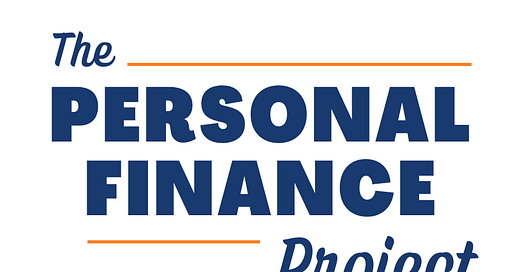Inflation, Interest, and Why We Care
What the fu*k has been happening to our economy? 🤨 A truly simple answer doesn't exist - but simple enough does, here in this edition of The Personal Finance Project Newsletter.
Inflation, Interest, and Why We Care
In this edition of The Personal Finance Project Newsletter:
Inflation
Interest Rates
Relevance
Inflation
Relative to the last 30 years, we are in a high-inflation economy. It sounds frightening - the media is skilled at fear-mongering - but I’m not quite as fearful. Let’s take an objective, logic-driven look at today's economic condition and what this means for us.
Inflation, in its most simple definition, is the increase (or inflation) of prices. Consider the price of a Big Mac - we’ve all noticed it has climbed since we were kids. Funny enough, The Big Mac Index (or BMI) (*LINK to economist*) looks at the rising price of a Big Mac from Mcdonald's across time and geography and found that what once cost $2.36 USD in 1996 cost us $5.81 USD in 2021. The BMI isn’t the only metric we use to track inflation, but it illuminates the rising prices that we are constantly experiencing.
It is less known that the government wants inflation. The government’s target inflation rate is 2% annually because the general belief is that slow and steady inflation helps stimulate economic growth and efficiency. Constant inflation is a debatable theory taught in business school - why would we want things to cost us more money? Wouldn’t production efficiency allow us to pay less instead of more? I won’t get into it here, but check out this article by Investopedia (*LINK*) if you’re interested in a pros-and-cons look at inflation.
Regardless of the theoretical debates, we have experienced inflation reach 5.7%, on a year-over-year basis, as of April 2023. In times like this, we undergo a decrease in purchasing power, meaning we cannot buy as much with $1 today as we could last year.
Interest Rates
A conversation about inflation cannot be had without mentioning interest rates - the two go hand-in-hand. The Bank of Canada (BoC) uses the overnight interest rate to influence inflation and economic growth. Decreasing the overnight interest rate will stimulate consumer spending and economic growth while increasing the overnight interest rate restrains these variables.
The overnight interest rate is relevant because it determines the interest rate that banks charge us on outstanding debt. The bank takes the overnight interest rate, tacks on a couple percent, and calls this their prime interest rate. They use the prime interest rate as a benchmark for the lending rate, typically adding different percentage points to this benchmark depending on the nature of the loan. For floating interest rates, changes in the overnight rate will affect the prime rate, which affects the final interest rate that determines our debt payment. Fixed interest rates, however, stay where they were when you took on the debt.
Relevance
Inflation reached 5.7% on a year-over-year basis as of April 2023.
Why though?
Well, here’s a quick rundown of what has been happening.
COVID lockdowns threatened our economy since they caused reduced employment income and prevented us from consuming goods and services in our community. The government took action to prevent an economic downturn in a couple of ways:
Government Stimulus During COIVD
They used money currently in the economy to distribute support payments to Canadians.
They printed money, adding it to the economy, to distribute support payments to Canadians.
They cut the overnight interest rate to decrease interest payment amounts, meaning that we could spend a smaller proportion of our money on debt payments and put it toward necessary expenses instead.
This economic stimulus was essential for keeping Canadian businesses alive and supporting citizens with necessary expenses. The downside, however, is that these actions drove prices beyond the 2% inflation target. Specifically, the redistribution of current money, the printing of new money, and the interest rate cuts all give Canadians more money to spend on goods and services. The increased demand for these purchases increases competition among buyers, who are ultimately willing to pay more, thus driving up prices.
Then, the economy reopened and Canadians were earning their employment income again. Increased earnings gave Canadians more money to spend on goods and services, which was bound to raise prices even further.
Since the government has a target of 2% inflation, it needed to take action to establish control of inflation, so it raised the overnight interest rate. Higher interest rates have created less spending among consumers since the size of our monthly debt payments has increased. The latest inflation report shows a decreasing inflation rate, demonstrating that government intervention has made some progress. Ultimately, only time will tell the story of inflation.
Who Cares?
Good question. Seriously.
Every Canadian is experiencing inflation, especially when purchasing necessities like rent and groceries.
That being said, some people feel these pressures more than others. Lower-income Canadians, especially those earning fixed income, high-interest and variable-interest debt holders, and small businesses are likely tightening their wallets to meet their payment obligations and keep afloat. The people who can handle inflationary pressures are those who can prioritize their spending, decrease their cash flow commitments, and eliminate high-interest debt (or lock into fixed interest rates).
One intriguing aspect of inflation is its relation to debt. In times of high inflation, some debt can be seen as a decently performing investment asset. Stay tuned for the next edition of The Personal Finance Newsletter as I explain how I use my student debt to take advantage of inflation.





